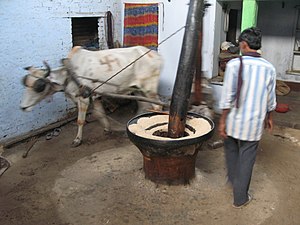Mustard oil/ja: Difference between revisions
Created page with "==栄養{{Anchor|Nutrition}}== マスタードオイル(100gあたり)は、884カロリーの食品エネルギーを含み、100%が脂肪である。脂肪組成は、飽和脂肪酸11%、一価不飽和脂肪酸59%、多価不飽和脂肪酸21%である。" Tags: Mobile edit Mobile web edit |
Updating to match new version of source page |
||
| Line 30: | Line 30: | ||
<div lang="en" dir="ltr" class="mw-content-ltr"> | <div lang="en" dir="ltr" class="mw-content-ltr"> | ||
==Essential oil== | ==Essential oil== | ||
The pungency of the [[Mustard (condiment)|condiment mustard]] results when ground mustard seeds are mixed with [[water]], [[vinegar]], or other liquid (or even when chewed). Under these conditions, a chemical reaction between the [[enzyme]] [[myrosinase]] and a [[glucosinolate]] known as [[sinigrin]] from the seeds of black mustard (''[[Brassica nigra]]'') or brown Indian mustard (''[[Brassica juncea]]'') produces [[allyl isothiocyanate]]. By [[distillation]] one can produce a very sharp-tasting [[essential oil]], sometimes called ''volatile oil of mustard'', containing more than 92% allyl isothiocyanate. The pungency of allyl isothiocyanate is due to the activation of the [[TRPA1]] ion channel in sensory neurons. White mustard (''[[Brassica hirta]]'') does not yield ''allyl'' isothiocyanate, but the milder [[4-Hydroxybenzyl isothiocyanate]] degraded from [[sinalbin]] rather than [[sinigrin]]. | The pungency of the [[Mustard (condiment)|condiment mustard]] results when ground mustard seeds are mixed with [[water]], [[vinegar]], or other liquid (or even when chewed). Under these conditions, a chemical reaction between the [[enzyme]] [[myrosinase]] and a [[glucosinolate]] known as [[sinigrin]] from the seeds of black mustard (''[[Brassica nigra]]'') or brown Indian mustard (''[[Brassica juncea]]'') produces [[allyl isothiocyanate]]. By [[distillation]] one can produce a very sharp-tasting [[essential oil]], sometimes called ''volatile oil of mustard'', containing more than 92% allyl isothiocyanate. The pungency of allyl isothiocyanate is due to the activation of the [[TRPA1]] ion channel in sensory neurons. White mustard (''[[Brassica hirta]]'') does not yield ''allyl'' isothiocyanate, but the milder [[4-Hydroxybenzyl isothiocyanate]] degraded from [[sinalbin]] rather than [[sinigrin]]. | ||
</div> | </div> | ||
Revision as of 20:39, 13 June 2025

マスタードオイルは、食用に圧搾された油、またはマスタード植物の刺激的な精油(揮発性油とも呼ばれる)のいずれかを意味する。精油は、マスタードシードを挽き、挽いたものを水と混ぜ、結果として生じる揮発性油を蒸留によって分離することで得られる。また、種子の乾留によっても生産できる。圧搾されたマスタードオイルは、一部の文化圏では食用油として使用されている。しかし、エルカ酸の含有量が高いため、一部の国では販売が制限されている。エルカ酸含有量の低いマスタードシードの変種が栽培された時期もある。
歴史
マスタードオイルは、現代のイスラエルにある古代ユダヤの町フコックで生産されていた可能性が高い。これは、急勾配の半円形のワイン桶や低い溝など、そこで見つかった特徴的な農業施設によって示唆されている。学者たちは、ローマ時代またはビザンツ時代に遡るこれらの構造が、マスタードの莢を 潰して油を製造するために使用されたと考えている。フコックでのマスタード生産は、エルサレム・タルムードにも記録されている。
圧搾油

油はマスタードシードの約30%を占める。これは、クロガラシ(Brassica nigra)、ブラウンマスタード(B. juncea)、ホワイトマスタード(B. alba)から生産できる。
料理での使用
独特の刺激的な風味を持つこの油は、主にアッサム料理、ベンガル料理、ネパール料理、北インド料理、そしてバングラデシュ料理で特徴的に使用されている。時折、ギーの代用品としても使われる。
化学組成
その刺激的な風味は、マスタード科(アブラナ科)植物(例えば、キャベツ、ホースラディッシュ、ワサビ)のファイトトケミカルであるアリルイソチオシアネートに由来する。
マスタードオイルは、約60%の一価不飽和脂肪酸(エルカ酸42%、オレイン酸12%)、約21%の多価不飽和脂肪酸(オメガ-3のα-リノレン酸6%、オメガ-6のリノール酸15%)、そして約12%の飽和脂肪酸を含んでいる。
キャノーラ油中のエルカ酸
マスタードオイルは最大50%のエルカ酸を含むことがある。エルカ酸はキャノーラ油の成分であり、エルカ酸レベルが総脂肪酸の2%を超えず、キャノーラ油が純粋である場合、ヒトが摂取しても安全な食品成分とみなされている。
規制
米国食品医薬品局は、高エルカ酸含有量のため、米国での料理用圧搾マスタードオイルの輸入または販売を禁止している。対照的に、FDAはエルカ酸含有量がはるかに低い精油マスタードオイルを一般的に安全と認められるとして分類しており、食品への使用を許可している。圧搾マスタードオイルは、米国では「外用のみ」という表示が義務付けられたマッサージオイルとして許可されている。
栄養
マスタードオイル(100gあたり)は、884カロリーの食品エネルギーを含み、100%が脂肪である。脂肪組成は、飽和脂肪酸11%、一価不飽和脂肪酸59%、多価不飽和脂肪酸21%である。
Essential oil
The pungency of the condiment mustard results when ground mustard seeds are mixed with water, vinegar, or other liquid (or even when chewed). Under these conditions, a chemical reaction between the enzyme myrosinase and a glucosinolate known as sinigrin from the seeds of black mustard (Brassica nigra) or brown Indian mustard (Brassica juncea) produces allyl isothiocyanate. By distillation one can produce a very sharp-tasting essential oil, sometimes called volatile oil of mustard, containing more than 92% allyl isothiocyanate. The pungency of allyl isothiocyanate is due to the activation of the TRPA1 ion channel in sensory neurons. White mustard (Brassica hirta) does not yield allyl isothiocyanate, but the milder 4-Hydroxybenzyl isothiocyanate degraded from sinalbin rather than sinigrin.
Allyl isothiocyanate serves the plant as a defense against herbivores. Since it is harmful to the plant, it is stored in the harmless form of a glucosinolate, separate from the enzyme myrosinase. Once the herbivore chews the plant, the noxious allyl isothiocyanate is produced. Allyl isothiocyanate is also responsible for the pungent taste of horseradish and wasabi. It can be produced synthetically, sometimes known as synthetic mustard oil.
関連項目
| この記事は、クリエイティブ・コモンズ・表示・継承ライセンス3.0のもとで公表されたウィキペディアの項目Mustard oil(31 May 2025, at 02:31編集記事参照)を翻訳して二次利用しています。 |